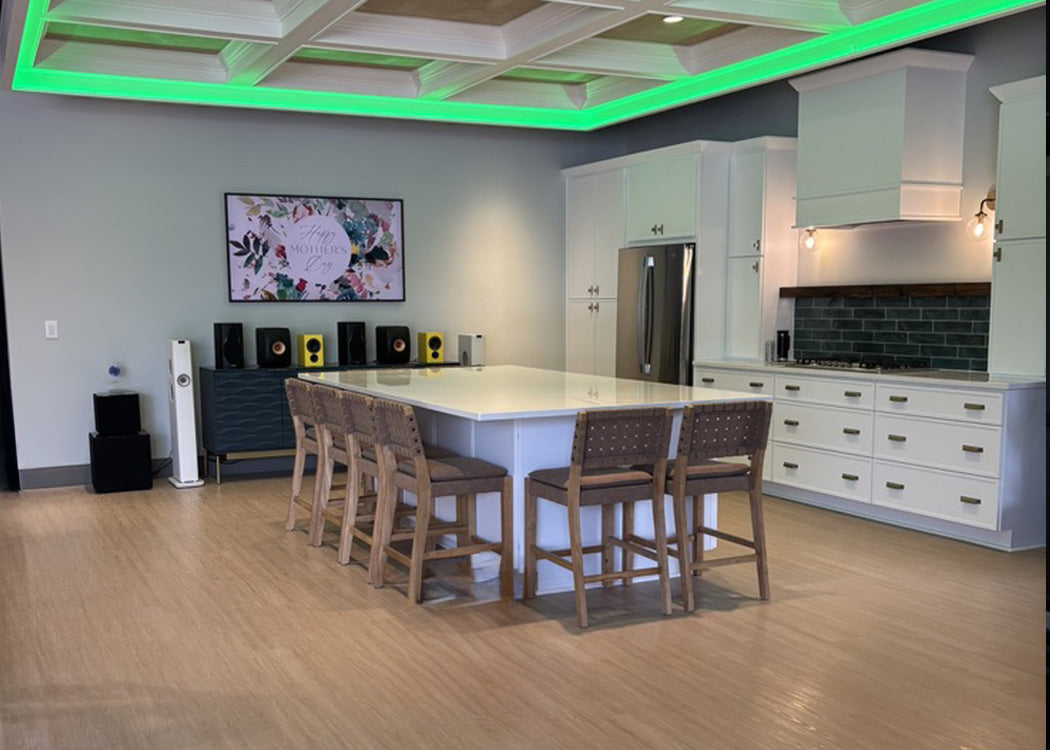Say Goodbye to Copper
For Klipsch aficionados, this might seem like a negative. Copper and black are the brand’s signature colors and have set the tone (see what we did there) for more than three-quarters of a century. But, trust us, it’s a welcome change to better match the overall aesthetics of products in the Heritage-inspired family.
The Sevens and The Nines powered monitors come in the traditional Heritage-inspired colors, walnut, and matte black. The grilles are magnetic and can easily be removed.
What is striking about both sets of powered monitors is the look of the edge-to-edge 90° X 90° Tractrix horns and low-frequency, high-excursion fiber-composite cone woofers (6.5” for The Sevens, 8” for The Nines). Not only are they black, a chrome bar separates them from the horns with the words, “Established 1946 | USA” with the Klipsch Heritage-inspired script logo on the bottom of the horn. Simple, sleek, and elegant. The principles of mid-century modern design remain, including tactile knobs on the top of the primary speaker and wood veneers.
What Are the Differences Between The Sevens and The Nines Powered Monitors?
Without question, both pairs of powered monitors deliver room-filling sound. But, there are some key differences to consider specific to size.
Yes, this will sound fairly simple, pun intended. The Sevens powered monitors are bigger than the Fives. The Nines powered monitors are bigger than The Sevens.
But, this is a good place to take into account the size of your room for speaker placement. The Sevens are ideal for a small to medium-sized living room or home office. The Nines, on the other hand, are only slightly smaller than the Klipsch Heresy IV floorstanding speakers.
Anyone familiar with Klipsch Heritage and Heritage-inspired speakers knows they are loud as hell. The Nines provide that level of sound with the largest Tractrix horns and woofers of any Klipsch powered monitor on the market. They would be ideal for a large recording studio, a cavernous basement, or a large living room.
Beyond the size, these two powerful pairs of monitors deliver sound quality you can find in professional recording studios or the movie theater.
All the Connections
The input capability of The Sevens and The Nines powered monitors are pretty tough to beat. For starters, both speakers feature HDMI-arc, which was first seen in The Fives. ARC is a type of audio transmission directly linking the speaker outputs to your TV remote. HDMI ARC requires only one cable and sends audio backward, from a TV into powered monitors or a soundbar. Put more simply, it’s a form of digital sound processing. Much like JRR Tolkien’s famous series of books, HDMI ARC equates to, “one remote to rule them all” in the home theater realm.
It's hard to be competitive in the powered monitor market without having a best-in-class Bluetooth option these days. The Sevens and The Nines both have Bluetooth 5, allowing a user to walk across their home without dropping the wireless signal from their phone, tablet, or laptop. For example, our reviewer walked from her home office at the front of her 1500-square-foot home to the back of her master bedroom and the audio remained crystal clear, with no delays or drops.
The Sevens and The Nines have an optical input for CD players or a TV, a USB input, and a 3.5mm analog input. We tested the analog input with an AUX cord and an Amazon Alexa voice-assisted device. Alexa performed as quickly as when commands are read when it is plugged into older powered monitors.
Both powered monitors also offer the same phono/line analog connection as The Fives, so you can plug your turntable into the powered monitors and have a truly unique experience with your favorite records.
We tested both pairs using a recent reissue of Joy Division’s “Closer,” the final album from the seminal post-punk band. Ian Curtis’ disembodied vocals come through the monitors as though you are standing next to legendary producer Martin Hannett in a Manchester, UK recording studio in 1980.
Should You Use These Powered Monitors as a Home Theater System?
In a word, yes. The Sevens and The Nines powered monitors are engineered so you can have a 2.0 home theater system straight away. While Klipsch center channels have long been some of our favorites, it’s not necessary for these speakers.
As a test, we watched the pivotal final battle scene in “Avengers: Endgame” and the trailer for Season Three of “The Mandalorian,” a show where much of the dialogue is heard through a helmet, on both The Sevens and The Nines.
The dialogue could be heard loud and clear across the board. We also listened to Carly Simon’s “You're So Vain” on both sets of powered monitors. The cameo appearance of a certain British rock icon on the backing vocals was unmistakable, something you can’t always pick out with other speakers. Note - this is an uncredited backup singer, but #iykyk.
Klipsch also makes it easy if you want to add a subwoofer for a 2.1 home theater setup. While you don’t really need it, you do have the option.






































